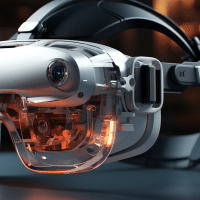
Virtual reality (VR) is a technology that has been around for decades, but has recently become more accessible and popular. It is a simulated environment that can be experienced through a headset, allowing users to interact with the environment in a realistic way.
There are three types of virtual reality: non-immersive, semi-immersive, and fully immersive. Non-immersive virtual reality is the most basic type of VR. It is a simulated environment that is experienced through a computer monitor or television screen. This type of VR does not require a headset and is often used for educational or entertainment purposes. Semi-immersive virtual reality is a more advanced type of VR. It is experienced through a headset and allows users to interact with the environment in a more realistic way. This type of VR is often used for gaming and training purposes.
Finally, fully immersive virtual reality is the most advanced type of VR. It is experienced through a headset and allows users to interact with the environment in a completely realistic way. This type of VR is often used for gaming, training, and medical purposes. Overall, virtual reality is a technology that has been around for decades, but has recently become more accessible and popular. There are three main types of virtual reality: non-immersive, semi-immersive, and fully immersive. Each type of VR has its own unique uses and benefits.
Let’s list some examples of how these types of virtual reality are being used in different sectors:
- Education: Non-immersive VR is frequently utilized in classrooms, providing a rich, engaging learning environment that can take students on virtual field trips or simplify complex subjects.
- Training: Semi-immersive VR is especially useful in sectors where real-world training is unsafe or impractical. This includes pilot training in aviation, soldier training in the military, or emergency response practice for firefighters.
- Medical: Fully immersive VR is increasingly used in the medical field for both training and treatment. For instance, it’s used to simulate surgeries for training purposes, or as a form of therapy for patients with PTSD.
These are just a few instances demonstrating the limitless potential of VR technology across different sectors.

Non-Immersive Virtual Reality
Virtual reality is a rapidly growing technology that has the potential to revolutionize the way we interact with the world. Non-immersive virtual reality, one of the three types of virtual reality, offers an accessible and affordable experience. Unlike other types, non-immersive virtual reality doesn’t require the user to wear a headset or specialized equipment. It utilizes a computer monitor or display device to create a virtual environment, allowing users to explore and engage.
This versatile form of virtual reality finds extensive applications in education, providing students with immersive experiences, whether it’s a virtual tour of a museum or an in-depth lesson on a specific topic. Additionally, non-immersive virtual reality offers abundant entertainment possibilities, like playing video games or watching movies. With its accessibility and affordability, non-immersive virtual reality presents an excellent opportunity to delve into virtual reality without the need for costly equipment.
Semi-Immersive Virtual Reality
Virtual reality is a rapidly growing and evolving technology that is revolutionizing the way we experience and interact with the world around us. It offers us a remarkable opportunity to immerse ourselves in virtual environments, transporting us to places we could only dream of visiting.
When it comes to virtual reality, there are three main types: semi-immersive, fully immersive, and augmented reality. Each type has its own unique features and benefits, catering to different preferences and needs.
Semi-immersive virtual reality, in particular, stands out as a highly accessible and affordable option for those who are just starting out on their virtual reality journey. With minimal hardware and setup requirements, it offers a gateway into the captivating world of virtual experiences without breaking the bank.
In a semi-immersive virtual reality setup, users can engage with virtual environments through a headset and controllers while still remaining aware of the real world around them. This means that they can enjoy the best of both worlds – the excitement and immersion of the virtual realm, combined with the ability to see and hear their physical surroundings.
Whether you’re exploring a stunning virtual landscape, engaging in thrilling virtual adventures, or simply indulging in creative and interactive experiences, semi-immersive virtual reality allows you to stay connected to reality while embarking on extraordinary virtual journeys.
Immersive Culinary Tours: Exploring Global Cuisines Through VR
Google Earth VR: Leap into a New Dimension
Best VR Games of This Year – Explore Around!
So, if you’re someone who desires to dip your toes into the world of virtual reality without completely disconnecting from the real world, semi-immersive virtual reality is the perfect choice for you. It offers a seamless blend of the virtual and the real, unlocking a whole new realm of possibilities and experiences. Get ready to embark on your own personal virtual odyssey!
Fully-Immersive Virtual Reality
Fully-immersive virtual reality represents the apex of VR technology, offering unparalleled levels of immersion and realism. This type of VR typically requires more sophisticated equipment, such as high-quality headsets, haptic feedback devices, and dedicated VR rooms. In a fully-immersive VR setup, all senses are engaged, creating an environment that feels incredibly real. Users can interact with the virtual world in ways that mimic real-world interactions, providing an experience that is both thrilling and immersive.
Whether you’re walking on a foreign planet, diving under the sea, or exploring historical events, fully-immersive virtual reality transports you to different realities, offering an unmatched level of immersion. It’s an ideal choice for those seeking a complete departure from reality and a deep dive into the incredible world of virtual experiences.
Virtual reality (VR) is a fully-immersive experience that allows users to explore and interact with a simulated environment. It has become increasingly popular in recent years, with the technology becoming more accessible and affordable. There are three main types of virtual reality: non-immersive, semi-immersive, and fully-immersive.
Non-immersive virtual reality is the most basic form of VR. It typically involves a user wearing a headset and using a controller to interact with a virtual environment. This type of VR is often used for gaming and entertainment purposes. Semi-immersive virtual reality is a more advanced form of VR. It involves the user wearing a headset and using a controller to interact with a virtual environment, but also includes the use of physical objects such as a treadmill or a joystick.

This type of VR is often used for educational and training purposes. Finally, fully-immersive virtual reality is the most advanced form of VR. It involves the user wearing a headset and using a controller to interact with a virtual environment, but also includes the use of physical objects such as a treadmill, a joystick, and a motion-tracking system. This type of VR is often used for medical, military, and industrial applications. Overall, virtual reality is an exciting technology that has the potential to revolutionize the way we interact with the world.
With the three types of virtual reality, users can explore and interact with a simulated environment in a variety of ways.
The Types of Virtual Reality: Powered by Hardware and Software
Virtual reality (VR) is a rapidly growing technology that is revolutionizing the way we interact with the world. It is a computer-generated simulation of a three-dimensional environment that can be interacted with in a seemingly real or physical way.
There are three main types of virtual reality hardware and software: immersive, augmented, and mixed reality. Immersive virtual reality is the most popular type of VR. It is a fully immersive experience that completely blocks out the real world and transports the user into a virtual environment. This type of VR requires a headset, such as the Oculus Rift or HTC Vive, and a powerful computer to run the software. It is used for gaming, entertainment, and educational purposes.
Augmented reality (AR) is a captivating technology that merges digital images seamlessly with the real world, enriching the user’s experience by adding virtual elements. By leveraging computer vision and advanced algorithms, AR enhances our perception and interaction with the environment. Mixed reality (MR) is an exciting technology that combines the immersive experience of virtual reality (VR) with the real-world integration of augmented reality (AR).
By seamlessly blending virtual elements with our physical environment, MR creates a captivating hybrid space where digital and real-world objects coexist. These are the three main types of virtual reality hardware and software. Each type has its own unique features and applications, and all three are revolutionizing the way we interact with the world.
This innovative technology finds applications in various fields, including gaming, engineering, and architecture. In the gaming industry, MR offers players an unprecedented level of immersion by integrating virtual objects into the player’s real surroundings. In engineering and architecture, MR enables professionals to visualize and interact with virtual models in real-time, facilitating design iterations and enhancing collaboration.
With its ability to merge the best aspects of VR and AR, mixed reality opens up a world of endless possibilities, revolutionizing how we perceive and interact with digital content in our physical reality.
AR finds applications in various domains, including navigation, where it provides real-time guidance and overlays relevant information on the user’s view. In gaming, AR opens up new dimensions of immersive gameplay, where virtual characters and objects coexist with the real world. Moreover, AR has made significant contributions to medical training, allowing students and professionals to simulate complex procedures and visualize anatomical structures in a realistic manner.

With its endless possibilities, AR continues to revolutionize industries and unlock new opportunities for innovation and creativity. As this technology evolves, we can expect even more seamless integration of virtual and real-world elements, further blurring the boundaries between the physical and digital realms.
Conclusion
In conclusion, virtual reality is an ever-evolving technology that has the potential to revolutionize the way we interact with the world. There are three main types of virtual reality: augmented reality, mixed reality, and virtual reality. Augmented reality is a technology that overlays digital information onto the physical world.
Mixed reality combines the physical and digital worlds to create a more immersive experience. Finally, virtual reality is a completely immersive experience that transports users to a completely digital world. Each type of virtual reality has its own unique advantages and disadvantages, and it is up to the user to decide which type of virtual reality best suits their needs.
Virtual reality (VR) is a rapidly growing technology that has the potential to revolutionize the way we interact with the world. This article explored the three main types of virtual reality: non-immersive, semi-immersive, and fully-immersive.
We also discussed some of the hardware and software available for each type of VR. Non-immersive VR is the most basic form of virtual reality, allowing users to interact with a virtual environment without the need for a headset. Semi-immersive VR requires a headset and allows users to interact with a virtual environment in a more realistic way. Fully-immersive VR requires a headset and allows users to interact with a virtual environment in a completely realistic way.
Get in the Game with Play Station VR 2!
Supercharge Your STEM Education in Minutes!
The possibilities for virtual reality are endless, and the technology is only going to continue to improve. With the right hardware and software, virtual reality can be used for a variety of applications, from gaming to education to business. As the technology continues to evolve, it will open up new opportunities for people to explore and interact with the world in ways never before possible. In conclusion, virtual reality is an incredibly exciting and rapidly evolving technology that holds immense potential to revolutionize the way we interact with the world around us.
With the right combination of cutting-edge hardware and software, users are able to immerse themselves in a vast array of virtual environments, each offering a uniquely realistic experience.
Imagine being able to explore uncharted territories, distant planets, or even historical eras, all from the comfort of your own home. With virtual reality, the possibilities are truly limitless. As the technology continues to advance and improve, it will undoubtedly unlock even more opportunities for people to delve into new realms of exploration and interaction.
We wholeheartedly invite you to join us on this thrilling journey into the world of virtual reality. Let us embark together and discover the boundless possibilities that await us in this remarkable realm.


















